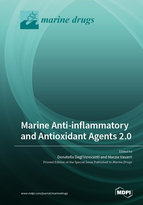Marine Anti-inflammatory and Antioxidant Agents 2.0
A special issue of Marine Drugs (ISSN 1660-3397).
Deadline for manuscript submissions: closed (20 September 2022) | Viewed by 35007
Special Issue Editors
Interests: bioactive natural products; inflammation; oxidative stress; polyphenols; cell migration; autophagy
Special Issues, Collections and Topics in MDPI journals
Interests: bioactive natural products; inflammation; oxidative stress; polyphenols; cell migration; autophagy
Special Issues, Collections and Topics in MDPI journals
Special Issue Information
Dear Colleagues,
Oxidative stress and inflammation are two closely related biological phenomena, each of which can be induced by the other. Indeed, inflammation is a physiological response to harmful agents (e.g., pathogens, damaged cells, or toxic compounds) that involves the innate and adaptive immune systems. Activation of the inflammatory cascade involves the initiation of intracellular signaling pathways that regulate the expression of pro-inflammatory mediators. Furthermore, during inflammation, inflammatory cells release a variety of reactive oxygen species (ROS) and nitrogen species (RNS) at the site of inflammation, triggering uncontrolled oxidative stress. Oxidative stress occurs due to an imbalance between the production of ROS and the availability of antioxidants or radical scavengers. High levels of ROS can cause the oxidation of biomolecules (e.g., proteins, lipids, and DNA) and induce the activation of pro-inflammatory transcription factors.
This interrelationship between uncontrolled oxidative stress and inflammation is a key factor in the progression of several chronic diseases with important consequences for human health.
A large number of anti-inflammatory agents are commercially available; however, many cause non-negligible adverse effects associated with chronic use. In recent decades, the use of natural products with anti-inflammatory and antioxidant activities has become increasingly popular in the efforts to meet the challenge of developing new safe and effective alternative agents to conventional drugs.
In this regard, the sea is an invaluable and rich resource of molecules with potential antioxidant and anti-inflammatory power.
In this Special Issue, we aim to collect in vitro and/or in vivo experimental investigations highlighting the role of marine-derived bioactive compounds as modulators of inflammation and/or oxidative stress.
Papers describing the mechanisms of action and molecular interactions of compounds isolated from marine organisms are particularly encouraged. In addition, comprehensive review articles summarizing knowledge on marine anti-inflammatory and/or antioxidant agents in support of human health will also be considered.
Prof. Dr. Donatella Degl'Innocenti
Dr. Marzia Vasarri
Guest Editors
Manuscript Submission Information
Manuscripts should be submitted online at www.mdpi.com by registering and logging in to this website. Once you are registered, click here to go to the submission form. Manuscripts can be submitted until the deadline. All submissions that pass pre-check are peer-reviewed. Accepted papers will be published continuously in the journal (as soon as accepted) and will be listed together on the special issue website. Research articles, review articles as well as short communications are invited. For planned papers, a title and short abstract (about 100 words) can be sent to the Editorial Office for announcement on this website.
Submitted manuscripts should not have been published previously, nor be under consideration for publication elsewhere (except conference proceedings papers). All manuscripts are thoroughly refereed through a single-blind peer-review process. A guide for authors and other relevant information for submission of manuscripts is available on the Instructions for Authors page. Marine Drugs is an international peer-reviewed open access monthly journal published by MDPI.
Please visit the Instructions for Authors page before submitting a manuscript. The Article Processing Charge (APC) for publication in this open access journal is 2900 CHF (Swiss Francs). Submitted papers should be well formatted and use good English. Authors may use MDPI's English editing service prior to publication or during author revisions.
Keywords
- marine organisms
- marine compounds
- inflammation
- inflammation-related disease
- pro-inflammatory cytokines
- antioxidant agents
- anti-inflammatory agents
- oxidative stress
- ROS/RNS
Related Special Issues
- Marine Anti-inflammatory and Antioxidant Agents 3.0 in Marine Drugs (10 articles)
- Marine Anti-inflammatory Agents 2020 in Marine Drugs (6 articles)
- Marine Anti-inflammatory and Antioxidant Agents 2021 in Marine Drugs (11 articles)








